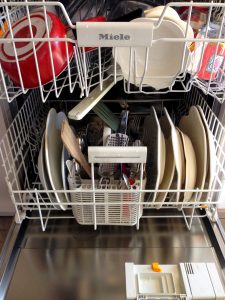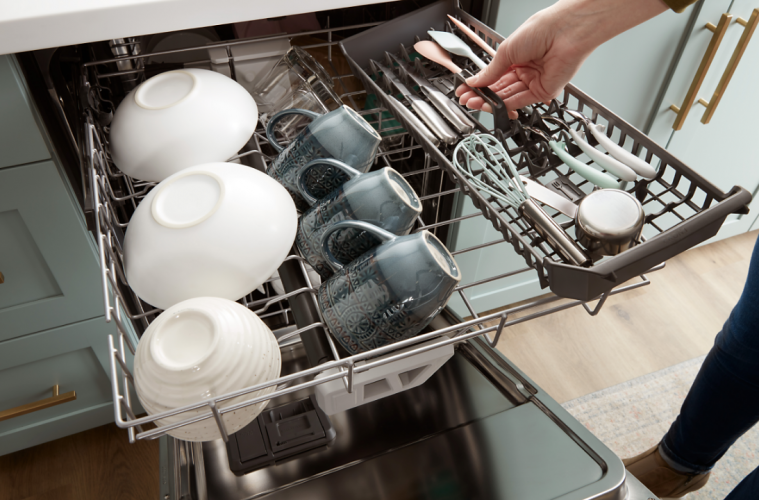Is your dishwasher not cleaning your dishes properly? Are you left with remnants on your dishes, water spots or foggy glassware when you are unpacking your dishwasher?
These could have been easily avoided by simply knowing where and how things should go — a small solution to a big problem. Properly loading your dishwasher can also boost its cleaning performance and maintain its quality in the long run.
Rugby legend ‘The Beast’ (Tendai Mtawarira) shares his tips for packing a dishwasher:
1. Scrape and skip the pre-rinse
Dishwashing detergent is designed to interact with food residue, such as sauces. In fact, it cleans more effectively when there is residue on dishware. So, forget pre-rinsing and simply scrape your plates, and load, for a better clean while saving time, effort, and water.
2. Make space
Avoid overcrowding or overlapping when loading your dishwasher, and always allow space between items so water flows and drains freely. This prevents residue from becoming trapped to ensure a thorough cleaning.
Alternate small and large plates, as well as spoons and forks. Position items between dishwasher tines, not over them. This firmly fixes them in place, preventing breakage when sprayed with water.
3. Don’t block spray arms and the detergent dispenser
Give them space to work effectively. Place trays or large items on the side of the dishwasher, instead of the front or centre. Before closing the door, gently spin the spray arm to ensure it is not obstructed.

Pexels
4. Is it dishwasher-safe?
Typically, these items should be hand washed:
● Nonstick cookware (may lose coating)
● Cast iron, aluminium, and ceramic pots and pans
● Sharp knives
● Sharp attachments (from blenders, food processors)
● Wooden items
● Fine China
● Delicate glassware
Why? Because pans may lose their nonstick coating, wooden spoons or cutting boards can warp, and knives can lose sharpness when placed in a dishwasher.
While hand washing is usually recommended for wine glasses, there are dishwashers that offer programmes and accessories such as GlassCare that gently and firmly hold glass stems and bodies in place with their unique SoftGrip and SoftSpikes, protecting them from vibration, cracks, and breakage.
5. Clean cutlery
If your dishwasher has a cutlery basket, position your spoons and forks upright (handles down), and your knives downward (handles up). This rule of thumb ensures maximum cleaning and safety. Alternate spoons and forks to let water reach every nook and cranny and prevent food residue from remaining on the cutlery.
6. A clean dishwasher means clean dishes
A monthly dishwasher clean will prevent the build-up of food residue and other grime in the crevices of your dishwasher. It’s easy – simply scrub the strainer clean then run it on a hot water cycle with a bowl of vinegar inside.
For a deeper clean once or twice a year, scrub parts, such as spray arms and detergent dispenser, with soapy water to clear any blockages.
Best to test if you have hard water as this may cause discoloration and mineral film on the surface of your machine. If confirmed, use a citric-acid-based dishwasher cleaner to remove deposits.
7. Unload the bottom rack first
A simple unloading strategy can change your dishwashing game. Since water may collect in the items of the top rack, unloading them first may pour wastewater on your freshly cleaned dishware below. So unload from the bottom rack towards the top to prevent this.

Pexels
8. When it comes to large plates and bowls…
Place them sideways between the dishwasher tines, facing inward towards the spray arms. To optimise space between each plate, alternately large and small plates
9. Glasses and mugs
Place cups, glasses, and mugs upside down along the sides of the top rack. To avoid dripping and pooling at the base of the glasses, position them at an angle to let water easily roll down. When loading, don’t let the glasses touch to prevent water spots.
10. Loading and function
The most economical use of your dishwasher is to run with a full load (not overloaded) that will reduce the number of times you need to use it each day – saving energy and money.
Don’t discount the useful half-load option, which is great for a quick wash if you are entertaining.
The half-load function on a dishwasher uses less water compared to a regular cycle, as water is only spraying one-half of the appliance. This may save some money, particularly for those with an eco valve.
Original article by Flux Communications on Food&Home.
Feature image: Pexels


